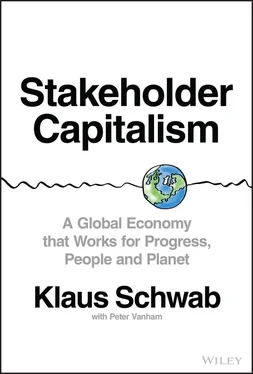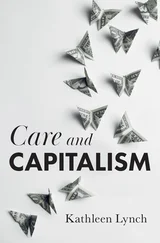Klaus Schwab - Stakeholder Capitalism
Здесь есть возможность читать онлайн «Klaus Schwab - Stakeholder Capitalism» — ознакомительный отрывок электронной книги совершенно бесплатно, а после прочтения отрывка купить полную версию. В некоторых случаях можно слушать аудио, скачать через торрент в формате fb2 и присутствует краткое содержание. ISBN: , Жанр: economics, на английском языке. Описание произведения, (предисловие) а так же отзывы посетителей доступны на портале библиотеки ЛибКат.
- Название:Stakeholder Capitalism
- Автор:
- Жанр:
- Год:неизвестен
- ISBN:9781119756149
- Рейтинг книги:4 / 5. Голосов: 1
-
Избранное:Добавить в избранное
- Отзывы:
-
Ваша оценка:
- 80
- 1
- 2
- 3
- 4
- 5
Stakeholder Capitalism: краткое содержание, описание и аннотация
Предлагаем к чтению аннотацию, описание, краткое содержание или предисловие (зависит от того, что написал сам автор книги «Stakeholder Capitalism»). Если вы не нашли необходимую информацию о книге — напишите в комментариях, мы постараемся отыскать её.
Individual agency:
A clearly defined social contract:
Planning for future generations:
Better measures of economic success: Stakeholder Capitalism: A Global Economy that Works for Progress, People and Planet
Stakeholder Capitalism
Stakeholder Capitalism — читать онлайн ознакомительный отрывок
Ниже представлен текст книги, разбитый по страницам. Система сохранения места последней прочитанной страницы, позволяет с удобством читать онлайн бесплатно книгу «Stakeholder Capitalism», без необходимости каждый раз заново искать на чём Вы остановились. Поставьте закладку, и сможете в любой момент перейти на страницу, на которой закончили чтение.
Интервал:
Закладка:
Inequality in continental Europe is slightly less pronounced, with 37 percent of income captured by the top 10 percent of earners. While inequality has been rising, it has done so at a considerably slower pace than in most other leading economies. This is partially due to Europe's greater system of check and balances to facilitate income distribution and redistribution.
But some uncomfortable realities remain here, too. In much of Southern and Eastern Europe, for example, unemployment remains stuck at high levels, especially for the young. Well-paid jobs there are increasingly hard to get, often to the detriment of both blue-collar workers and university-educated youth. Even Northern European economies, which kept a decent growth pace after the European debt crisis put a strain on Europe-wide growth as of 2010, saw their income inequality levels rise in the past decade. Counterexamples such as Belgium, 73Estonia, Romania, Slovakia, or the Czech Republic, 74which experienced declining inequality, remain the exception.
Wealth, Health, and Social Mobility
The Kuznets curve has been disproved when looking at other inequality metrics too. Wealth inequality, which reflects the savings, investments, and other stocks of capital individuals have, is even more lopsided in many countries. And, in lockstep with this wealth disparity, private education and quality health care, which can require large sums of money, are becoming more of a privilege reserved for the upper-middle and upper classes. This is especially the case in countries without proper public alternatives.
This reality is perhaps most keenly felt in the United States, which in this sense looks more like the emerging markets of India and Mexico than the advanced economy it is. Economists Emmanuel Saez and Gabriel Zucman calculated that the wealth held by the one percent richest Americans rose from less than 15 percent in the 1970s to over 40 percent in the early 2010s. 75As such, wealth inequality is twice as high as income inequality. 76
These two inequalities—wealth and income—also build on one another and create a vicious cycle. 77A 2020 Financial Times article summarized that by the end of September 2019, a record 56 percent of all US equities was held by the top one percent wealthiest households, amounting to $21.4 trillion. Read that again: the “one percent” does in fact own more than half of all stocks in America. That percentage had steadily gone up in the past three decades, and the rise had been “driven by stagnant wages for many Americans, which held them back from partaking in the stock market's gains of the past decade.”
The 0.1 percent made even greater strides. They accumulated well over a fifth of America's wealth by the 2010s, a share almost three times higher as in the mid-1970s. Those at the bottom, on the other hand, saw their wealth share and savings plummet, to the point even of often not being able to cover for health emergencies and education, 78as has become painfully clear during the 2020 pandemic.
The consequence of this increasing wealth disparity, Nobel Prize–winning economist Joseph Stiglitz asserts, is that US economic mobility is increasingly a thing of the past; even a long or healthy life is out of reach for many. He decried the situation in his 2019 book People, Power and Profits: Progressive Capitalism for an Age of Discontent , and a prior Scientific American essay. “Families in the bottom 50 percent hardly have the cash reserves to meet an emergency,” he wrote. “Newspapers are replete with stories of those for whom the breakdown of a car or an illness starts a downward spiral from which they never recover. In significant part because of high inequality, US life expectancy, exceptionally low to begin with, is experiencing sustained declines.” 79
And indeed, the phenomenon Anne Case and Angus Deaton called “deaths of despair,” 80is on the rise in America (and increasingly, the UK 81). People are falling off the economic ladder and wither or die because of opioid overdoses, depression, or other health issues associated with their poor economic status.
No phenomenon displays this “wealth and health” nexus in America more than COVID-19, which affected those with fewer means much more than others. New York City provides a striking example. In the early weeks of the pandemic, many of the wealthier Manhattanites could seek shelter in an upstate or out-of-state property, get care in a private hospital, or otherwise protect themselves from the virus. Poorer New Yorkers, by contrast, were much more exposed. They were more likely to work and live in at-risk environments, less likely to have adequate health care coverage, and largely unable to physically move elsewhere. As a result, one early study found, “Coronavirus-related hospitalizations and deaths were highest in the Bronx, which has the highest proportion (38.3%) of African Americans and the lowest annual median household income ($38,467) and proportion (20.7%) of residents with at least a bachelor's degree.” 82That pattern repeated itself elsewhere in the United States—and indeed the world.
But despite the global trend of diseases like COVID hitting poorer communities harder, in other advanced economies, health disparities have so far remained much more constrained, and life expectancy continues to rise. This should hardly come as a major surprise, as outside the US virtually all advanced economies have some form of universal health care. Among the 36 member states of the Organization for Economic Co-operation and Development, for example, only Mexico had a lower percentage of people covered than the US, and most countries achieved a 100 percent coverage rate, 83either through public or primary private health insurance.
The global record on social and economic mobility are more mixed. The World Economic Forum's 2020 Global Social Mobility index found that “there are only a handful of nations with the right conditions to foster social mobility” and that “most countries underperform in four areas: fair wages, social protection, working conditions and lifelong learning,” even as achieving higher levels of social mobility is an important part of implementing a stakeholder-based model of capitalism. Specifically, the report said:
Looking at all economies and average income levels, those children who are born into less affluent families typically experience greater barriers to success than their more affluently born counterparts. Furthermore, inequalities are rising even in countries that have experienced rapid growth. In most countries, individuals from certain groups have become historically disadvantaged and poor social mobility perpetuates and exacerbates such inequalities. In turn, these types of inequalities can undermine the cohesiveness of economies and societies. 84
Other studies found similar dynamics. A 2018 World Bank report showed that only 12 percent of young adults in regions like Africa and South Asia have more education than their parents—often a prerequisite to climb higher up the socioeconomic ladder. 85Other regions, including East Asia, Latin America, and the Middle East and Northern Africa, did see their average economic mobility improve, according to the report. But it also warned, “While mobility tends to improve as economies get richer, there is nothing inevitable about this process. Rather, as economies develop, mobility is likely to increase if opportunities become more equal, which typically requires higher public investments and better policies.” 86In other words: lacking public investments—an increasingly likely reality for budget-strained governments—economic mobility in many countries could get worse , rather than better.
So, what would Simon Kuznets have to say about all these findings, many of which go against his own theory?
Читать дальшеИнтервал:
Закладка:
Похожие книги на «Stakeholder Capitalism»
Представляем Вашему вниманию похожие книги на «Stakeholder Capitalism» списком для выбора. Мы отобрали схожую по названию и смыслу литературу в надежде предоставить читателям больше вариантов отыскать новые, интересные, ещё непрочитанные произведения.
Обсуждение, отзывы о книге «Stakeholder Capitalism» и просто собственные мнения читателей. Оставьте ваши комментарии, напишите, что Вы думаете о произведении, его смысле или главных героях. Укажите что конкретно понравилось, а что нет, и почему Вы так считаете.












